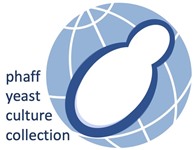Yeast Identification Project
 Chen Zeng wrote this based on his experience as a student researcher while pursuing his Master of Food Science at Cornell University.
Chen Zeng wrote this based on his experience as a student researcher while pursuing his Master of Food Science at Cornell University.
Yeasts are microorganisms classified as fungus and they have different uses compared to bacteria. Saccharomyces cerevisiae is a species of yeast that are commonly used in brewing, winemaking, and baking. Although this species is used in many different occasions, each S. cerevisiae strain can vary a little, producing unique taste and flavor.
There was a story about how a yeast strain at Phaff Yeast Culture Collection was used in the food industry.
Boston Beer Company once wanted to recreate a vintage recipe from the 1970s using a yeast strain called 36C4 but the company that supplied the brewery went out of business a long time ago. Fortunately, a student intern that worked at the brewery in 1977 had also worked with the yeast collection at UC Davis and preserved the original yeast 36C4 strain. Therefore, they were able to produce this beer with the original yeast strain.1
This is part of what Phaff Yeast Culture Collection is doing: collecting unique yeasts from all over the world, and it all started with a scientist named Herman Phaff.2 Today, it has become the one of the largest public collections of wild yeasts in the world and 80% of them are not available from other sources.
In order to find out what these novel yeasts can do, it is important to know who their ancestors are. Before gene sequencing technology was available, this identification process involved up to 80 characterization tests so that we could compare the physiological data. Now, this can be done by doing a DNA sequencing on a specific region. My job was to trim out the noise and identify if there is a similarity within this region. If there is a large identical section, it is very likely that there are evolutionary relationships between the sequences. Once this information is obtained, we can verify our predictions on a strain’s physiological behavior by a series of lab tests. Currently, these yeast strains are distributed for both academic and industrial research. Besides possible applications in food industry,3 they have “commercial value for industrial fermentations including ability to consume inexpensive feedstocks such as xylose or pectin, produce enzymes, or tolerate stresses such as temperature, pH, or salinity.” These novel yeasts can very possibly be solutions to a more sustainable food and farming system.
1What is it like to be a yeast collection curator? United States Culture Collection Network. 2020. https://usccn.org/what-is-it-like-to-be-a-yeast-collection-curator/
2History of the collection. Phaff Yeast Culture Collection. 2022. https://phaffcollection.ucdavis.edu/history-collection
3Phaff yeast culture collection grows by 6,000 strains – new NSF award. BFTV Cluster News. 2021. https://news.bftv.ucdavis.edu/food-science-and-technology/phaff-yeast-culture-collection-grow-6000-strains-new-nsf-award
The contents of this posting, our website, and our other publications, including Vegetarian Journal and Vegan Journal, are not intended to provide personal medical advice. Medical advice should be obtained from a qualified health professional. We often depend on product and ingredient information from company statements. It is impossible to be 100% sure about a statement, info can change, people have different views, and mistakes can be made. Please use your best judgment about whether a product is suitable for you. To be sure, do further research or confirmation on your own

Yay for the fungi!
I’m wondering how we would know if all these ‘natural occuring yeasts’ are actually natural occurring or can we trace them in a way to see if there has been genetic modification? I think a lot of that is going on these days. Amazing the foresight some people have, like Dr. Phaff!